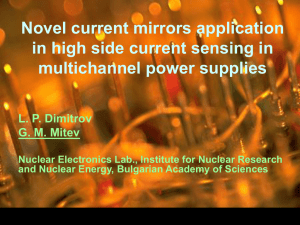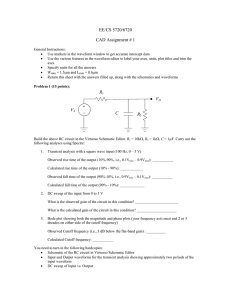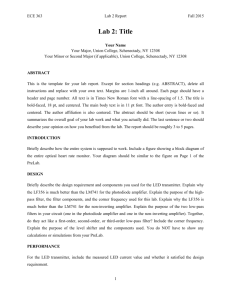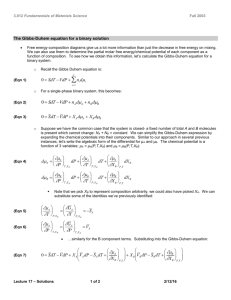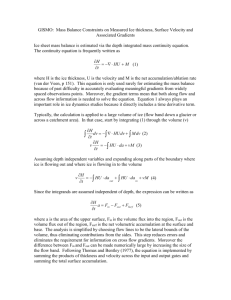Homework Assignment 9 — Solutions
advertisement
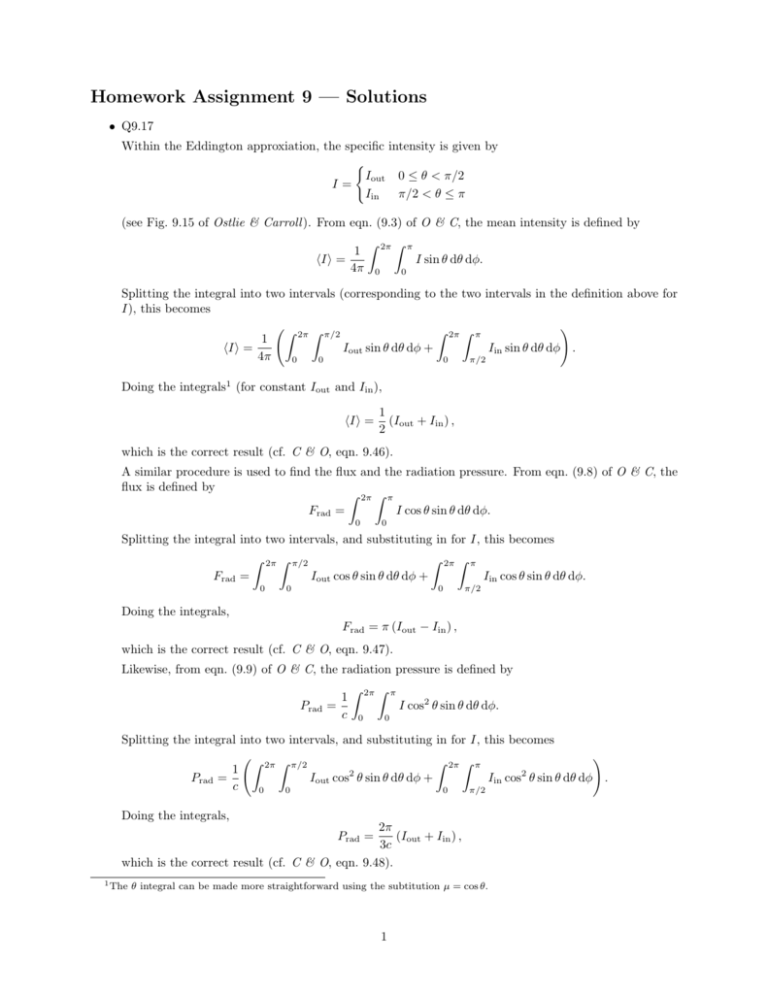
Homework Assignment 9 — Solutions • Q9.17 Within the Eddington approxiation, the specific intensity is given by ( Iout 0 ≤ θ < π/2 I= Iin π/2 < θ ≤ π (see Fig. 9.15 of Ostlie & Carroll ). From eqn. (9.3) of O & C, the mean intensity is defined by hIi = 1 4π 2π Z Z π I sin θ dθ dφ. 0 0 Splitting the integral into two intervals (corresponding to the two intervals in the definition above for I), this becomes ! Z 2π Z π/2 Z 2π Z π 1 hIi = Iout sin θ dθ dφ + Iin sin θ dθ dφ . 4π 0 0 0 π/2 Doing the integrals1 (for constant Iout and Iin ), hIi = 1 (Iout + Iin ) , 2 which is the correct result (cf. C & O, eqn. 9.46). A similar procedure is used to find the flux and the radiation pressure. From eqn. (9.8) of O & C, the flux is defined by Z 2π Z π Frad = I cos θ sin θ dθ dφ. 0 0 Splitting the integral into two intervals, and substituting in for I, this becomes 2π Z π/2 Z Frad = 2π Z π Z Iout cos θ sin θ dθ dφ + 0 0 Iin cos θ sin θ dθ dφ. 0 π/2 Doing the integrals, Frad = π (Iout − Iin ) , which is the correct result (cf. C & O, eqn. 9.47). Likewise, from eqn. (9.9) of O & C, the radiation pressure is defined by Prad = 1 c Z 2π 0 Z π I cos2 θ sin θ dθ dφ. 0 Splitting the integral into two intervals, and substituting in for I, this becomes Prad 1 = c Z 2π Z π/2 Z 2 2π Z Iout cos θ sin θ dθ dφ + 0 0 ! π Iin cos θ sin θ dθ dφ . 0 π/2 Doing the integrals, 2π (Iout + Iin ) , 3c which is the correct result (cf. C & O, eqn. 9.48). Prad = 1 The θ integral can be made more straightforward using the subtitution µ = cos θ. 1 2 • Q9.18 Solving the radiative transfer equation within the Eddington approximation give the mean intensity as 4π 2 hIi = Frad τv + . 3 3 (cf. Carroll & Ostlie, eqn. 9.50). Substituting in eqn. (9.46) for the mean intensity, this becomes 2π 2 (Iout + Iin ) = Frad τv + . 3 3 This equation is combined with eqn. (9.47), Frad = π(Iout − Iin ), to give a pair of simultaneous equation for Iout and Iin . First eliminating Iin , we obtain 2π Frad 2 Iout + Iout − = Frad τv + . 3 π 3 Rearranging leads to the result Iout 3 4 = Frad τv + . 4π 3 Substituting this back into the flux equation (9.47) leads to the corresponding expression for Iin , Iin = 3 Frad τv . 4π (Note that I = 0 at τv = 0, in accordance with the boundary conditions used to derive eqn. 9.50). The anisotropy of the radiation field is characterized by the departure of the ratio Iout τv + 4/3 = Iin τv from unity. For a one percent anisotropy, as asked in the question, we have 1.01 = τv + 4/3 ; τv solving for the optical depth, we find τv = 133. • Q9.20 Within the Eddington approximation, eqn. (9.50) of Ostlie intensity hIi, 4π hIi = Frad τv + 3 & Carroll gives an expression for the mean 2 3 . For an atmosphere in radiative equilibrium, hIi = S, and so the source function is given (after a little rearrangement) by 3 2 S= Frad τv + . 4π 3 Applying this expression at optical depth τv = 2/3 gives S(τv = 2/3) = πFrad , which is the desired result. 2 • Q9.21 The general solution of the radiative transfer equation (9.54) is Z τλ,0 −τλ,0 Iλ (0) = Iλ,0 e + Sλ e−τλ dτλ 0 (I’ve flipped the integration order relative to Ostlie & Carroll, as this is a more intuitive way to write the solution). For a plane-parallel slab with no radiation entering from the outside (as stipulated in the question), Iλ,0 = 0 and so Z τλ,0 Iλ (0) = Sλ e−τλ dτλ . 0 If the source function does not depend on position, this simplifies to Z τλ,0 Iλ (0) = Sλ e−τλ dτλ = Sλ 1 − e−τλ,0 . 0 In the τλ,0 1 limit, the exponential term on the right-hand side goes to zero, and so Iλ (0) = Sλ . With the added assumption of thermodynamic equilibrium, the source function Sλ equals the Planck function Bλ , and so Iλ (0) = Bλ ; that is, the emergent radiation is blackbody radiation, the desired result. In the τλ,0 1 limit, the exponential term can be approximated using a first-order Taylor series expansion, eτλ,0 ≈ 1 − τλ,0 , and so Iλ (0) = Sλ (1 − 1 + τλ,0 ) = Sλ τλ,0 = Sλ κλ ρL, where the second equality follows because the opacity κλ and density ρ are constant througout the slab. Remembering that the source function is defined as Sλ ≡ jλ , κλ where jλ and κλ are the wavelength-dependent emissivity and opacity of the slab, it follows that Iλ (0) = jλ κλ ρL = jλ ρL; κλ therefore, the slab will show emission lines where jλ is large, the desired result. • Q9.22 The general solution of the radiative transfer equation (9.54) is Z τλ,0 −τλ,0 Iλ (0) = Iλ,0 e + Sλ e−τλ dτλ 0 If the source function does not depend on position, this simplifies to Z τλ,0 −τλ,0 Iλ (0) = Iλ,0 e + Sλ e−τλ dτλ = Iλ,0 e−τλ,0 + Sλ 1 − e−τλ,0 . 0 In the τλ,0 1 limit, the exponential terms on the right-hand side go to zero, and so Iλ (0) = Sλ . 3 With the added assumption of thermodynamic equilibrium, the source function Sλ equals the Planck function Bλ , and so Iλ (0) = Bλ ; that is, the emergent radiation is blackbody radiation, the desired result. In the τλ,0 1 limit, the exponential term can be approximated using a first-order Taylor series expansion, eτλ,0 ≈ 1 − τλ,0 , and so Iλ (0) = Iλ,0 (1 − τλ,0 ) + Sλ (1 − 1 + τλ,0 ) = Iλ,0 (1 − τλ,0 ) + Sλ τλ,0 . Since we have assumed τλ,0 < 1, this value lies somewhere between Iλ,0 and Sλ . To obtain absorption lines superimposed on the spectrum of the incident radiation (Iλ,0 ), we require Iλ (0) < Iλ,0 , which means that Sλ < Iλ,0 . Conversely, to obtain emission lines superimposed on the spectrum of the incident radiation, we require Iλ (0) > Iλ,0 , which means that Sλ > Iλ,0 . These are the desired results. • Q9.23 The general equation for the emergent intensity from a plane-parallel atmosphere is Z ∞ Iλ (0) = Sλ sec θ eτλ,v sec θ dτλ,v 0 (from eqn. 9.55 of Ostlie & Carroll ). Assuming a linearly varying source function Sλ = aλ + bλ τλ,v , the intensity becomes Z Iλ (0) = ∞ (aλ + bλ τλ,v ) sec θ eτλ,v sec θ dτλ,v 0 This integrates to ∞ Iλ (0) = −e− sec θτλ,v (aλ + bλ cos θ + bλ τλ,v ) 0 = aλ + bλ cos θ, which is the desired result. 4

